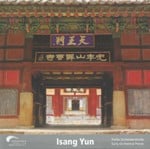2(II=picc).1.1.1-2.1.1.1-timp.perc(2):vib/cyms/tgl/SD/tam-t-strings
Abbreviations (PDF)
Bote & Bock
Bara (or para) is the name of a Korean percussion instrument, the cymbal. This slightly curved metal disc is mostly employed in pairs and occurs in a specific Korean-Buddhist ceremony: Parach’um (or Barach’um) is the name of the ritual "Dance with the Cymbals" performed in strides before the altar portrait of Buddha and transmitted to the present day. The motion sequence and props represent religious ideas manifesting themselves in the ceremony (to which the recitation and singing of the sutras belong and of which the dance is only one part) as prayers and their fulfillment: invocation and conjuration, thanksgiving and offering. The music here symbolizes the transitory, changing character of nature, whose many different phenomenal forms are based on a "reality" thought of as unchanging. Sound, as an acoustic event, opens up the possibility for the transcending of time and space and the entering into a union with the unchanging one of the Tao, the origin of becoming and passing away, in which all opposites coalesce and are canceled out.
After Yun had received the Seoul Culture Prize in 1955 (the highest distinction that he achieved in his own country), he went to Paris in 1956 in order to form connections with the European avant-garde. It was not until 1957 that the almost forty-year-old composer assimilated dodecaphonic technique under Josef Rufer, a pupil of Arnold Schönberg, at the Berlin Academy of Music. The twelve-tone row complemented Yun’s understanding of music insofar as it authenticates at every moment the tonality of the tone system: the whole is in the part; the part is in the whole. The principal equality of the twelve tones contradicted, however, his East Asian understanding of sound. For this understanding the gesturally ritualized course of the "single tone" is essential: the emphatic development to a long-drawn-out sound center and the tone conclusion usually still articulated on its own. In his work with twelve-tone technique, which guaranteed him rationality and economy of formal design, and through the process of recollection, beginning in Berlin, of the approximately thousand-year tradition of old Korean court music there began a process of self-discovery which also crystallized in the Bara orchestral piece.
After the Five Pieces for piano (1958), Music for Seven Instruments (1959), and String Quartet No.3 (1959/61), Bara was the fourth work regarded by Yun as valid. He concluded the composition in Krefeld in March 1960. Looking back in 1992, he commented, "The twenty or thirty pieces which I wrote in Korea and then in Paris ... that was all uncertain, in style, also in compositional technique: now quite progressive, now sentimental – cheap atmospheric elements which did not content me at all. Atonal music, twelve-tone music has a strict organization, a strict compositional frame. All the music composed only according to my free will, now here, now there, now West, now East – that is not any art. I do not regret that I destroyed these pieces." Yun always regarded as valid expression such works that had been composed out of inner necessity and exhibited a certain formal consistency, an internal developmental logic.
In Bara Yun’s sound technique derived from traditional Korean music had already largely established itself. Bara is at the same time a sound-plane composition: athematic but internally individualized sound planes are organized here by Yun in such a way that the idea of an organic, as it were, involuntary growth seems to be realized. The arching courses, the increasing and decreasing of the sound appear by and large in relatively static, block sound layering, much more rarely in the wavy up-and-down.
The key to the relation of heaven, earth, and humanity symbolically always intended as well in Yun’s composing lies in the "three worlds" symbolized by the instrumentation. The strings stand for the purity of heaven, the percussion instruments and in part the brass instruments too stand for the earthly demonic powers, and the woodwinds operate as mediating forces. Bara exhibits the tripartite design characteristic of Yun. The first part (Largo espressivo – Adagio molto misterioso) expounds the goal-oriented or "showing" perspective of the pure, long-drawn-out main tones in a process rising higher and higher, in which each instrumental group immediately reacts to the other. There are two striking chords of the brass instruments, also for the regeneration of the musical powers, and then an individualization through thematic designs (solos of the clarinet, the first violin, and the oboe), and finally an urging toward the peripeteia, to the great union. In the second part (Andante – Poco più mosso – Andante) Yun pursues the same dramaturgy with other means: he enlivens (and blurs) the clear main tones with successive part entries and melismatic developments to the main tone, and he dramatizes the contrasting sound layers, for example, by having the timpani played with the hard wooden drumsticks. The third part (Andantino – Allegro – Andante) begins with a wavy ascent and descent motion: the brief, upward gesturing of the strings is silenced by a drumbeat. In ecstatic accumulations of sound Yun heightens even more the opposition between motion and stillness.
Walter-Wolfgang Sparrer (2004, translated by Susan Marie Praeder)

NDR-Sinfonieorchester / Hiroyuki Iwaki
Internationale Isang Yun Gesellschaft IYG 003
